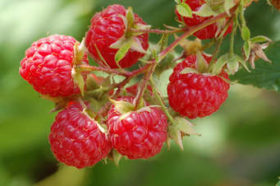 Along the trails at Crossroads, and also in home gardens, red raspberries are ripening, their juicy ruby-colored berries just waiting to be harvested or foraged by wildlife.
Along the trails at Crossroads, and also in home gardens, red raspberries are ripening, their juicy ruby-colored berries just waiting to be harvested or foraged by wildlife.
I always feel uncomfortable talking about plants as if they had motivation and problem solving abilities, but understand that plants “want” to reproduce, and through years and years of evolution, every plant has developed some strategy to disperse and plant seeds or to somehow create offspring.
If seeds simply dropped from the parent plant, even if there were enough light to foster germination, the seedlings would never be able to compete with the branches and roots of the parent plant. Clearly, in order to obtain the sunlight, moisture and nutrients it needs in order to survive, a baby plant must grow far from the parent plant.
Different plants have different ways of spreading seeds. Some seeds float on water or on the wind. Nuts are grains usually are transported by small mammals.
.
Most berries depend on wildlife. The actual seeds are exceedingly hard, while the fruit is soft and sweet. Countless species of mammals and birds love sweet red berries. They gulp them down and later (and somewhere else) the seeds are excreted in their droppings.
The seeds of some species are unable to germinate unless have passed through the digestive system of a mammal or bird. The sweet red berries are planted (along with a bit of fertilizer) ..often a long distance from parent plant.
Scientists speculate that so many of our favorite fruits are red because the color red is easy to see. Red certainly shows up against the background of green leaves to us. Scientists think that birds see colors better than humans, and also, that they are especially sensitive to the red end of the spectrum.
Giving an eye examination to a bird is tough, but from behavior, we can easily observe that at least some birds show a preference for red.
When researchers dissect a bird eye under a powerful microscope, they find that day-feeding birds have high numbers of color-receiving cells and also curious little red, orange and yellow droplets in the retina. They aren’t sure, but many researchers believe that the droplet act like filters, making it easier to for the birds to see red. If this is so, berries must stand out like neon in contrast to the drab (in bird’s eyes) background of green.
Before a berries picking foray, you might want to participate in a Family Program at Crossroads. Tuesday-Thursday, summer education Joan Wilkie will present activities which will interest learners of all ages.
During our Parking Lot expansion project, parking will be available much of the time, but when heavy equipment is present, we ask that visitors park at the Maintenance Building (first drive east of the main entrance) or at the Astronomy Campus parking lot (intersection of Cove Road and Utah Street).
Crossroads at Big Creek is made up of three properties: Ida Bay, The Cove, and the Big Creek Preserves. The Collins Learning Center, located at 2041 Michigan Street is open 1:00-3:00 Tuesday-Saturday during the summer. Restrooms and trails are always open.

